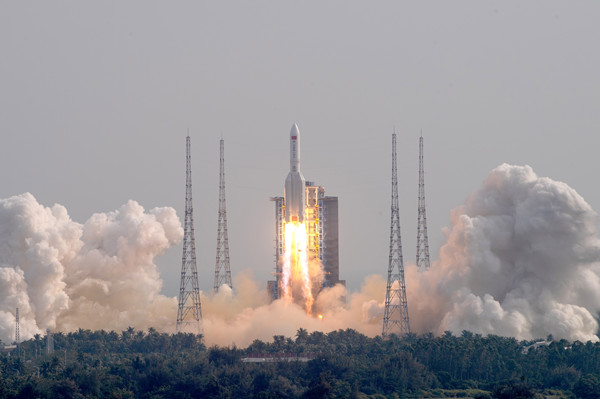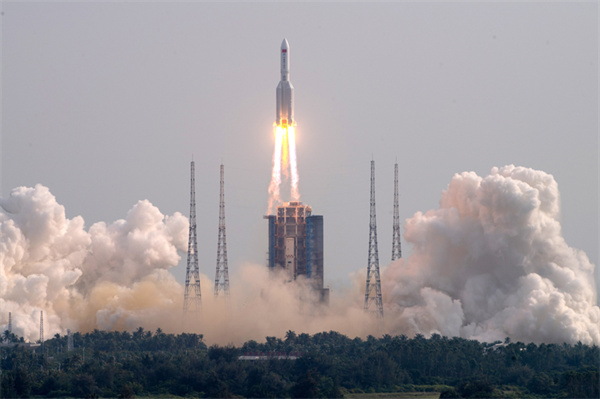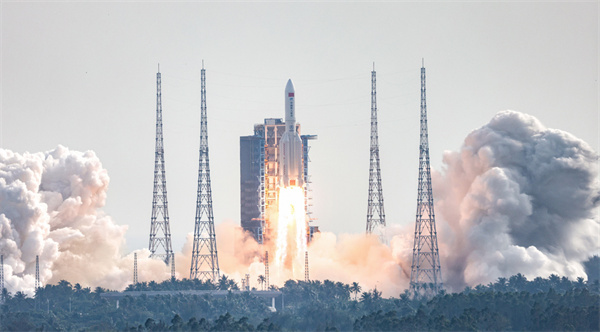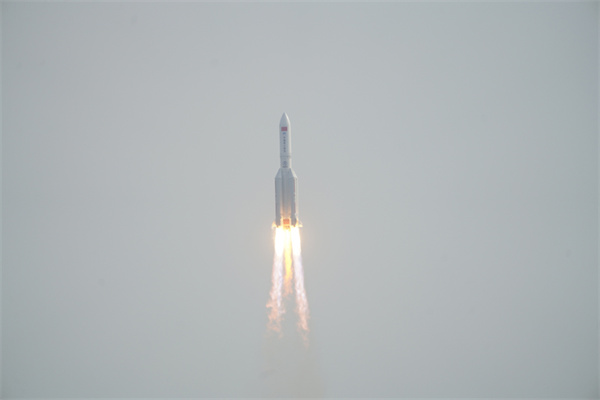
WENCHANG — China on Oct 31 launched the space lab module Mengtian, taking the construction of the country's space station Tiangong into final stage.
Mengtian, Tiangong's second lab module now flying to join the two-module combination already about 400 km above Earth, is the last "building block" that allows Tiangong to form a T-shape structure, the planned layout at the space station's completion.
The new combination is projected to take shape after a succession of elaborately-maneuvered tasks including the docking and the subsequent in-orbit transposition.
The Long March-5B Y4 carrier rocket, carrying Mengtian, blasted off from the Wenchang Spacecraft Launch Site on the coast of the southern island province of Hainan at 3:37 pm (Beijing Time), according to the China Manned Space Agency (CMSA).
About eight minutes later, Mengtian separated from the rocket and entered its preset orbit. The CMSA declared the launch a complete success.
This is the 25th flight mission since the country's manned space program was approved and initiated in 1992.
The building of Tiangong into a national space laboratory with three modules marks a milestone in China's three-decade effort to advance its manned space program.
NEW LAB
The 17.88-meter-long new module has a takeoff mass of about 23 metric tons. Consisting of a work cabin, a cargo airlock cabin, a payload cabin and a resource cabin, it is the heaviest single-cabin active spacecraft in orbit in the world right now.
The core module Tianhe combined with the Wentian lab module took on an L shape after the latter was moved at the end of September to park at a side port of the core module's node cabin, vacating the front docking port for Mengtian's berthing.
One of the challenges of Mengtian's docking task is a consequence of its relatively big orbital angle with the sun, which reduces the solar panel's energy production, said Song Xiaoguang, a designer of Tiangong's Guidance, Navigation and Control (GNC) subsystem.
"The docking must be completed within a limited period, otherwise it has to be halted and the solar arrays be adjusted to receive more sunlight," said Song. "To dock with an asymmetric structure with a tilted barycenter is also challenging," he added.
Mengtian is designed to be connected to the short message communication services provided by China's Beidou Navigation Satellite System. This channel can be used as an independent telecom link in case of emergency.
In addition, by using a custom-made app on a mobile phone, astronauts can contact their family members on Earth via text or voice messages. Three astronauts of the Shenzhou-14 mission are now waiting for the new workplace which has an available activity space of some 32 cubic meters.
FRONTIER EXPERIMENTS
Carrying eight science experiment cabinets and offering 37 extravehicular installation options, Mengtian will enable more in-cabin and out-of-cabin experiments, especially those frontier ones that only can be done in a micro-gravity environment.
Aboard the module is the world's first space atomic clock system consisting of a hydrogen clock, a rubidium clock and an optical clock. It is also the world's most accurate in-orbit time and frequency system.
The clock set will support fundamental physics research such as measuring the gravitational redshift and verifying the constant speed of light, said Zhang Shougang, chief designer of the high-accuracy time-frequency cabinet and director of the National Time Service Center of the Chinese Academy of Sciences (CAS).
"It can also be used to synchronize time for key science facilities like large particle accelerators and radio telescope arrays, and improve their performance," said Zhang.
Among Mengtian's payloads is a rack capable of producing ultra-cold quantum gas extremely close to the absolute zero, a cabinet with the ability to film — for the first time in a space station — material changes in high temperatures with X-rays, and a cutting-edge fluids physics lab in space.
These platforms will create conditions that cannot be achieved on Earth, thus serving as incubators for emerging technology and new materials like alloyed metal, crystals and semiconductors, said the payloads designers.
Mengtian also carries a toolbox equipped with a dexterous robotic arm and an augmented-reality smart glass to assist astronauts with maintenance.
China has built tech capability step by step in its manned space program, accumulating and learning to address technical complexities in the unfolding of each mission.
In November 2016, two astronauts including Chen Dong, now the commander of the Shenzhou-14 crewed mission, operated a mechanical arm within Tiangong-2, the space station's predecessor. Also in Tiangong-2, the first-ever cold atomic clock in space was tested.
Now, more tasks will be assigned to Chinese astronauts, as another cargo craft will arrive at the space station in November.
With the subsequent arrival of the Shenzhou-15 astronauts, the manpower in Tiangong will increase to six for a short period.
To facilitate the ins and outs of larger cargo and payloads, the airlock cabin of Mengtian is equipped with two square hatches, an internal one and an external one.
Plus, the external hatch is electrically driven, which is the first of its kind to be used in global space station history. This auto door reduces the astronaut's labor and increases efficiency when transporting cargo out of the cabin, said Bai Hemin, a designer for the space station system at the Shanghai Academy of Spaceflight Technology (SAST).
With a larger door, Mengtian is capable of releasing miniaturized satellites into space. "Astronauts can install the small satellites on a payload transfer device, depressurize the airlock cabin, and then convey them out of the cabin," said Meng Yao, a designer of Mengtian.
"The robotic arm outside the space station will grab the satellites and then catapult them in specified directions," said Meng from the SAST.


